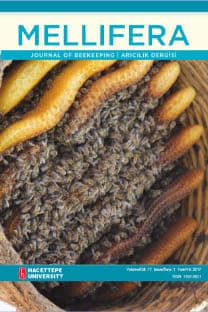Farklı bal arısı (A. Mellifera L.) genotiplerinden yetiştirilen ana arıların bazı özelliklerinin karşılaştırılması
Bu araştırmada saf Anadolu ve Kafkas bal arısı (Apis mellifera L.) ırkları ile karşılıklı melezlerinden Doolittle yöntemiyle ve yapay tohumlama tekniği kullanılarak 4 grup ana an yetiştirilmiştir. Yetiştirilen ana anlar için genotipe bağlı olarak aşılama randımanı, yumurtlama öncesi süre ile yumurtlama öncesi ve sonrası ana arı ağırlıkları incelenip karşılaştırılmışım Kafkas grubunda aşılanan larvaların %80,00'i arılarca kabul edilerek beslemeye alınırken; Anadolu grubunda larva kabul oranı %83,33 olarak bulunmuştur. Araştırmada saf ve melez Anadolu genotiplerinden yetiştirilen ana arıların Kafkas arılarına göre daha geç yumurtlamaya başladıkları; yumurtlama öncesi ve sonrası ana an ağırlıkları bakımından ise önemli bir fark bulunmadığı tespit edilmiştir.
A comparison of some features of queen bee rearing from different honeybee (Apis mellifera L.) genotypes
In this research, four groups of queen bees were developed from pure-bred Caucasian and Anatolian honeybees (Apis mellifera L.) and their cross-breeds using artificial insemination technique and Doolittle method. Then, insemination yield, the period up to the oviposition and queen bee weights in the pre-oviposition and post-oviposition periods were analyzed and compared depending upon genotype for the queen bees developed. While 80% of the larvae inseminated in the Caucasian group was accepted and properly fed by the bees, this rate was 83.33% in the Anatolian group. It was concluded that the queen-bees developed from the pure-bred and hybrid Anatolian genotypes began oviposition later than Caucasian queen bees. There was no significant difference between the groups in terms of pre-oviposition and post-oviposition weights of the queen bees.
___
- ISSN: 1302-5821
- Başlangıç: 2001
- Yayıncı: Hacettepe Üniversitesi
Sayıdaki Diğer Makaleler
Zoran STANIMIROVIC, Jevrosima STEVANOVIC, Dejan PEJOVIC, Milorad MIRILOVIC
Adapazarı-Karasu'da fındık zararlısına karşı kullanılan insektisitlerin bal arılarına etkisi
Dürdane KOLANKAYA, Belda ERKMEN, Aslı ÖZKIRIM, Kadriye SORKUN
Mısır'da üretilen farklı balların bazı arı ürünlerine göre antibakteriyel etkinliği
A. G. HEGAZİ, Nagia Z. MOHARRAM, Fayrouz ABD ALLAH, M. S. NOUR, A. M KHAIR
Erica manupuliflora Salisb. poleninin Morchella conica pers.'nın misel gelişimine etkisi
Türkiye'deki bazı endemik bitki türlerinde polen morfolojisi, total protein ve kimyasal analizler
